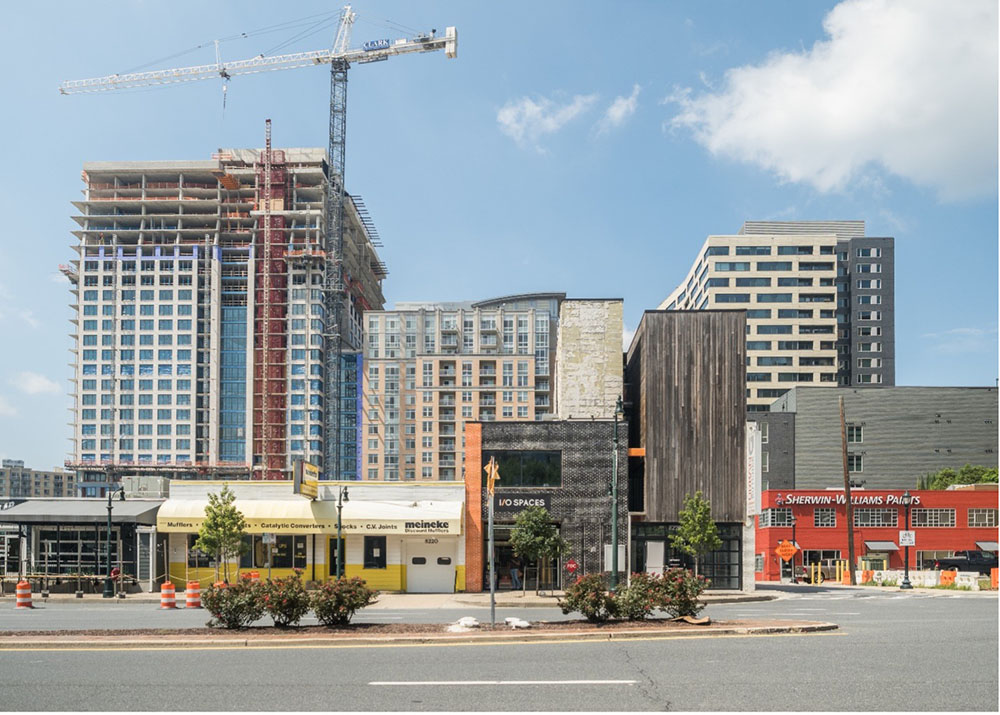By Lisa Govoni and Jason Sartori
Today we introduce a new series of blog posts on the housing market in Montgomery County, a series we hope will address some misconceptions, and clarify Montgomery Planning’s position on how to address one of the county’s most difficult challenges: the high price and limited availability of high-quality housing to serve our county’s racial equity/social justice, environmental, and economic needs.

Apartments and retail along Georgia Avenue in Silver Spring, MD
We thought it would be helpful to start this blog series by discussing Montgomery Planning’s position on housing and sharing some of the core tenets that guide our work program.
Montgomery County is a leader in housing policy, but we can and should do more. Montgomery County has long been a leader in housing policy. From the creation of the nation’s first inclusionary zoning program, the Moderately Priced Dwelling Unit program, in the 70s, to the recently implemented HOC production fund that aims to spur the production of more affordable housing, the county has a long history of being on the forefront of housing policy. But we recognize we need to do more. Almost 50% of renters in Montgomery County are cost-burdened – spending more than 30% of their income on housing. As stewards of the built environment, we have an important role in advocating and implementing land use plans and housing policies that adequately address the housing crisis.
Yes, we need to build much more housing. Montgomery County is one of the most diverse counties in the U.S. and people of all backgrounds, races, and ethnicities enjoy living in the various types of neighborhoods the county offers, from the Agriculture Reserve to the bustling downtowns. To maintain this diversity that we all treasure, we need to build more housing. When we fail to build enough housing, we see the impact in home prices and rents. This, in turn, influences who gets to live here and who doesn’t, who gets to build generational wealth through homeownership, and who gets squeezed out.
The market won’t solve everything. While building more housing overall is an important part of meeting the housing challenges of many moderate- and high-income households, as planners we also realize that the market is not going to solve all our housing issues, especially for our low- and moderate-income households. We also require a healthy supply of income-restricted affordable housing to meet the housing needs for those households making under 50% of Area Median Income (which is around $70,000 for a household of four). While the Planning Department does not generally play a large role in the implementation of affordable housing programs like LIHTC or Housing Choice Vouchers, we do have a role in land use through development review and master plans, processes that can help make it easier to build affordable housing. We also collaborate with our county, state and federal partners on creating programs and policies that ensure all Montgomery County residents have access to safe, accessible, and affordable housing.
Housing can help us meet other goals too. Building more housing can help us meet our environmental goals, by targeting the production of more homes near jobs and reducing vehicle miles traveled or improving stormwater management in the event of redevelopment. It also helps us increase our economic competitiveness, as attracting and retaining the employment base is necessary to support a healthy economy. Building more and more types of housing in more places around the county, while taking steps to avoid displacement, can help us meet our equity goals by ensuring more residents have access to our job centers and amenities.
New residents are a benefit to the county and the region. Often in the discussion about new housing, the conversation becomes bogged down by the impact new housing has on infrastructure. We agree that this is important, and while we have mechanisms in place to ensure the adequacy of our infrastructure, we should and will continue to strengthen those mechanisms to ensure Montgomery County continues to be a desirable place to live. But we can’t draw up the bridge behind us and stop growth out of fear of future impacts. We should embrace new neighbors for the benefits they bring to our neighborhoods – like increasing diversity, expanding the tax base, or improving the local economy. We should also embrace the new housing and diverse housing types that will ensure we’re meeting the needs of an increasingly diverse population.
"Thrive does not change the trajectory of the county, but rather recognizes the reality that we have already changed. We are no longer simply a bedroom community. We have vibrant activity centers along transit-rich corridors and this requires us to think differently about how we pursue our county’s future, most especially our housing needs."—Planning Director Gwen Wright
These are just a few of the core tenets that guide our work on land use and housing in Montgomery County. These principles are evident in the update of our General Plan, Thrive Montgomery 2050, which lays out a vision for guiding future land use and housing policy over the next 30 years. Addressing the housing affordability challenge requires a comprehensive vision like Thrive, where multiple tools, policies, and practices are identified to meet the housing affordability challenge. As our Planning Director, Gwen Wright says, “Thrive does not change the trajectory of the county, but rather recognizes the reality that we have already changed. We are no longer simply a bedroom community. We have vibrant activity centers along transit-rich corridors and this requires us to think differently about how we pursue our county’s future, most especially our housing needs.”
In future blog posts we’ll address and discuss some of Montgomery County’s most fiercely debated housing topics, including:
- Parking lots to places, recent trends in redevelopment and infill development – what kinds of uses are being redeveloped, and what kinds aren’t.
- How upzoning is necessary, though not sufficient to meet housing needs.
- The pandemic exodus that wasn’t, and related vacancy and rent trends.
Stay tuned!
 About the authors
About the authorsLisa Govoni is the Housing Policy Coordinator at the Montgomery County Planning Department, part of The Maryland-National Capital Park and Planning Commission (M-NCPPC). Lisa serves as the lead on major housing-related projects, including long-range sector planning activities and policy and zoning changes related to housing. Lisa completed her BA in Government and Politics in 2008, her MCP in Community Planning in 2011 and her MPS in Geographic Information Systems (GIS) in 2013, all from the University of Maryland, College Park.

Jason Sartori is the Chief of the Countywide Planning and Policy Division, which focuses on Montgomery County’s countywide planning efforts, including: transportation planning, transportation networks and modeling, public infrastructure adequacy monitoring (including schools), environmental resources, historic preservation, Vision Zero, zoning and housing policy. Jason joined the Planning Department in 2016, and has since helped lead two updates to the county’s adequate public facilities ordinance, known as the Growth and Infrastructure Policy. Jason previously served as the Associate Director of the National Center for Smart Growth at the University of Maryland.
Anonymous
There is a great deal of opposition to Thrive 2050 based on concerns about truly affordable housing, racial equity, and environmental impact. Yet, the Planning Board and its outgoing Chair continue to ram it through regardless of public concern. Shame on you.